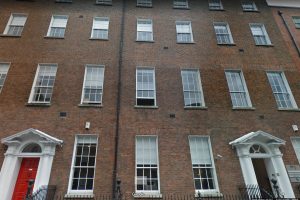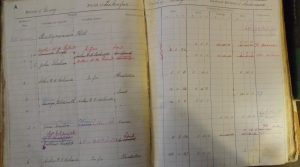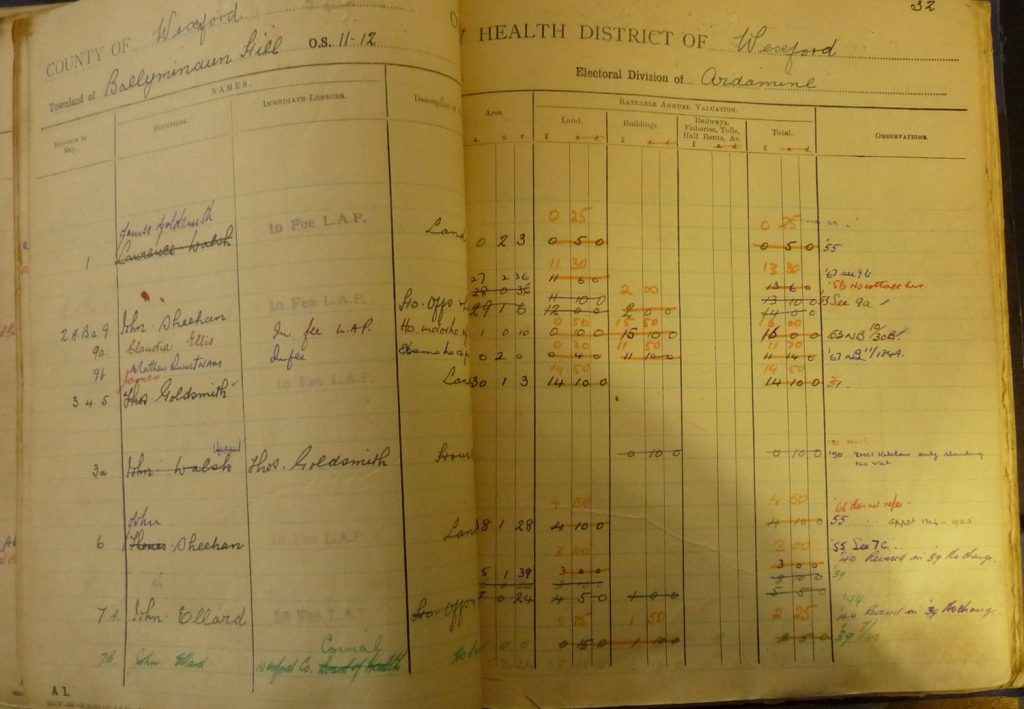The 1852 Act that (retrospectively) provided the legal underpinning for Richard Griffith’s great survey also envisaged annual revisions. It was a live tax record, after all, and needed to reflect changes in occupier, size of holding, name of lessor – anything that might affect the valuation and the tax payable. Some of Griffith’s local army of valuators must have remained in situ, supplying notice of changes to the central Office in Ely Place, Dublin.

The system in Dublin used a handwritten copy of the valuations, with amendments written over the original entry. Coloured pencils were employed to distinguish the year of the changes. (Unfortunately the microfilm copies made by the LDS Family History Library are in black and white.)
After a decade or so, the books would become increasingly difficult to read, so a fresh copy had to be made. The whole process then continued until that book in turn was cancelled and recopied.
Despite the original plans, full annual revisions were never a realistic prospect. The system eventually settled down to a natural rhythm, with a single revision (or “cancelled”) book covering fifteen or twenty years. For areas in the Republic, the revision process went on right up to the 1980s, when the local property tax was abolished, producing anything up to twelve separate books for a single area. In Northern Ireland the system changed in the 1930s and the most recent revisions are almost all for the 1920s.

The usefulness of the records is obvious: they provide a continual time-lapse record of every piece of property listed by Griffith, unbroken over the following century-and-a-half. Circumstantial evidence of death, emigration, money problems, family disputes – the revision books can contain them all.
Most importantly, the massive shift in land ownership to small tenant farmers that took place around the start of the twentieth century, and the fierce land hunger that drove it, means that there is almost certainly a family relationship between those who own the land now and those recorded in the revision books then. In other words, the books can provide excellent evidence of living relatives.

The books are available for areas in the Republic at the Valuation Office in the Irish Life Centre, Lower Abbey Street, Dublin. The VO is currently scanning the full collection with a view to making it available online. For the moment, the scans are only available onsite in the public office. Areas covered are Cos Carlow, Cork, Donegal, Dublin, Galway, Kerry, Limerick, Mayo, Meath, Monaghan, Offaly, Roscommon. Sligo and Tipperary.
The Revision Books for Northern Ireland are in PRONI. An excellent PRONI sub-site allows online research by placename on the full set, with links to high-quality scans of the originals. Even for people without Ulster ancestor, the sub-site gives a great sense of just how useful these wonderful records can be.
Thank you for this update with the good news that the Republic’s revision books are being scanned. My Irish ancestors range from Cork to Antrim. I was able to find my Antrim 3x great-grandmother, who is in Griffith’s, in the revision books online. When she disappeared, I thought she was dead and spent years looking for the record. What a shock when I found her, age 62, in a covered wagon headed west to Kansas where she lived another 23 years. Later I had the thrill of sharing tea on the Antrim family farm with my 3rd cousin, once removed. These books are a treasure. Thanks again.
Wow, what a truly uplifting and exciting report! Thanks for sharing!
One of my favourite sources..
A wonderful resource, providing deaths, emigration dates and much more. Even if your counties haven’t been digitized you can use the actual books in the Valuation office. Be sure to bring a thumb drive and a camera.
With a bit of courtesy, the staff at the Valuation Office in Dublin has been very helpful in retrieving the correct books. A great resource for family history.
With my research totally based in the north and living ‘Down Under’, I love PRONI’s Valuation Revision Lists and have shared their usefullness with many a fellow researcher. The fact that they are in colour is really essential for working out the year your ancestor’s land transfer was noted. This may well be a couple of years after the person passed away if the area lists weren’t revised in the year of death.
The scanning and digitising of the revision books may be useful for people abroad, but is very slow for the regular visitors in the Valuation Office.
Now that the majority of the books are digitised, increasingly I have to make several visits where I would have completed an area in a single session using the hard copy original books.
Of course the originals are becoming tattered especially from being put in the photocopier. The best solution would be to print facsimile hard copies which can be quickly browsed in the VO.
The information to be found in the books is superb, but it should be known that errors can occur in these like everything else. An ancestor who died in 1900 was still shown as lessor of one property in 1967, although most of his portfolio was correctly recorded in the name of his daughters.
Recently a lot could not be found in the name of a farmer, searching a small area in a number of townlands, although the farmer was mentioned in newspapers as an occupier. Presumably the valuator never checked if a change of occupier had taken place.
Nevertheless they are an essential element in researching family and local history.
My great great grandfather was one of the Valuation Officers. So always interested to read anything about it. The office were able to dig up a record of all the staff and officers with their years of service, rank and salary dated 1872. Gave me great insight into a lot…
The Valuation Office in Dublin is one of the most venerable of Civil Service Offices, having commenced operations in 1830 under the leadership of Sir Richard Griffith, Bart. who was the first Commissioner of Valuation. The valuation records which are kept in the Office are among the most treasured of property records and are available for viewing by the general public. The staff are most courteous and helpful and most importantly are suitably knowledgeable. A visit to this Government Office is definitely an uplifting experience.
Thanks Patty.
I have been spending months examining the Revisions for Carrowclare and Carrowreagh and others adjoining in Co Derry tracing Moore ancestry to build some trees. To be able to do this from Australia has been fantastic and they are a marvellous online resource. However, a little family history knowledge is needed to understand and interpret some successions. And a lot of time differentiating people with the same names especially when BDM records are patchy. It has been a fascinating and very lengthy family history project.